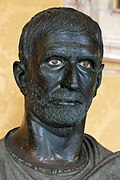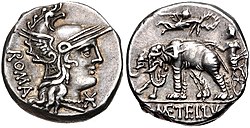Roman Republic
The Roman Republic was a phase in history of the Ancient Roman civilization. According to legend, the city of Rome was founded by Romulus in c. 750 BC. It was a kingdom until 510 BC, when the last King, Lucius Tarquinius Superbus was overthrown. Then began the Roman Republic.
Roman Republic Res publica Romana | |||||||||
|---|---|---|---|---|---|---|---|---|---|
| 509 BC–27 BC | |||||||||
 | |||||||||
| Capital | Rome | ||||||||
| Common languages | Latin (official) Etruscan, Greek, Osco-Umbrian, Venetic, Ligurian, Rhaetian, Nuragic, Sicel, Hebrew, Aramaic, Syriac, Punic, Berber, Illyrian, Iberian, Lusitanian, Celtiberian, Gaulish, Gallaecian, Aquitanian (unofficial, but commonly spoken) | ||||||||
| Religion | Roman polytheism | ||||||||
| Government | Constitutional republic | ||||||||
| Consuls | |||||||||
• 509–508 BC | Lucius Junius Brutus, Lucius Tarquinius Collatinus (first) | ||||||||
• 27 BC | Octavian, Marcus Vipsanius Agrippa (last) | ||||||||
| Legislature | Legislative Assemblies Roman Senate | ||||||||
| Historical era | Classical antiquity | ||||||||
• | 509 BC | ||||||||
• Dissolution of the Latin League | 338 BC[1] | ||||||||
• Caesar proclaimed dictator | 47 BC | ||||||||
| 2 September 31 BC | |||||||||
• | 16 January 27 BC | ||||||||
| |||||||||
| Today part of | |||||||||
The Roman Constitution was mainly an oligarchy but with some democratic features. The Roman people elected various officials including consuls, who ruled for about a year, from among a few noble families. Many of the ideas of the Roman Republic are still used today.
The Roman Republic got most of its wealth from trading and taxation. The Roman army was the strongest in Italy. It was constantly battling the Gauls, who were later conquered by Caesar. The Punic Wars against Carthage were fought all over the Mediterranean coasts, mainly because of disputes over Sicily and trade. The third enemy was the Germanic tribes or other barbarians (uncivilized people).
The Roman Republic suffered many disasters, including Spartacus (the leader of a slave revolt) who defeated one consul's army before he was captured. Also, Hannibal crossed the Alps and then defeated the Roman army at Cannae and many other battles, which saw Rome greatly fear being destroyed by Carthage.
The end of the Roman Republic is still a matter of dispute, and different scholars will give different dates for it. Usually, the dates of the start of either the First Triumvirate or the Second Triumvirate are given. The triumvirates were groups of three men who had much power.
The end of the Roman Republic is often said to be Gaius Julius Caesar's appointment as dictator (single ruler) by the Roman Senate. That happened after a series of civil wars lasting from about 49 BC to 44 BC.
Some people say the Roman Republic ended with the naval Battle of Actium between Marcus Antonius and Octavian. Both had been in the Second Triumvirate. The battle was fought on 2 September 31 BC in which Octavian won. Later, he was proclaimed Roman emperor. The end date could also be when Octavian was given the title of the first Augustus by the Senate, on 16 January 27 BC.
Those are modern views, however. In the view of the early emperors, the Res Publica (Republic, literally "Thing of the People") still existed but was simply "under their protection". They promised that some day that the Republic would restored to its original form. That never happened and so scholars divide the Roman Empire and the Roman Republic as two different and distinct periods in the history of Rome.
Roman Republic Media
The "Capitoline Brutus", a bust possibly depicting Lucius Junius Brutus, who led the revolt against Rome's last king and was a founder of the Republic.
Animated overview of the Roman territorial history from the Roman Republic until the fall of its last remnant the Byzantine Empire in 1453 at the end of the post-classical era.
The Latin League before Rome's expansion
Bust of Pyrrhus, found in the Villa of the Papyri at Herculaneum, now in the Naples Archaeological Museum
Coin of Hiero II of Syracuse
Temple of Janus as seen in the present church of San Nicola in Carcere, in the Forum Holitorium of Rome, Italy, dedicated by Gaius Duilius after his naval victory at the Battle of Mylae in 260 BC
Denarius of Gaius Caecilius Metellus Caprarius, 125 BC. The reverse depicts the triumph of his great-grandfather Lucius, with the elephants he had captured at Panormos. The elephant had thence become the emblem of the powerful Caecilii Metelli.[4]
References
- ↑ "Latin League". Encyclopaedia Britannica.
- ↑ Crawford, Roman Republican Coinage, pp. 455, 456.
- ↑ Taagepera, Rein (1979). "Size and Duration of Empires: Growth–Decline Curves, 600 BC to 600 AD". Social Science History. 3 (3/4): 115–138 [125]. doi:10.2307/1170959. JSTOR 1170959.
- ↑ Crawford 1974, pp. 292–293.






